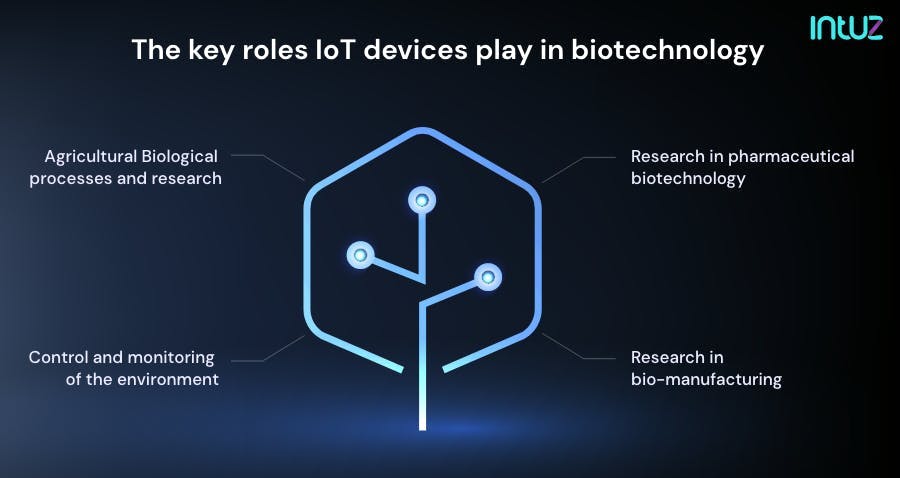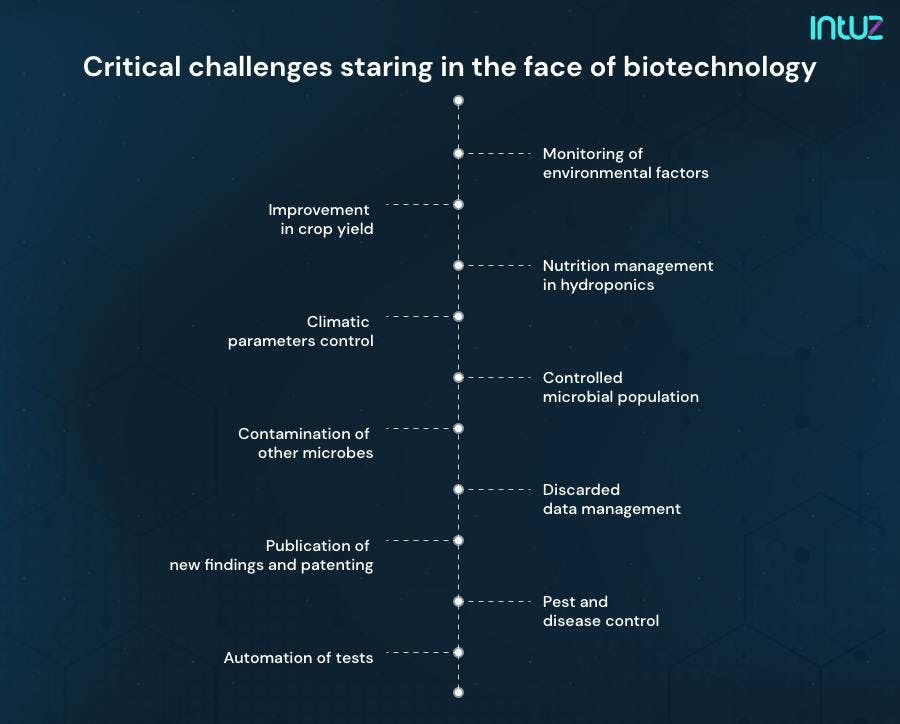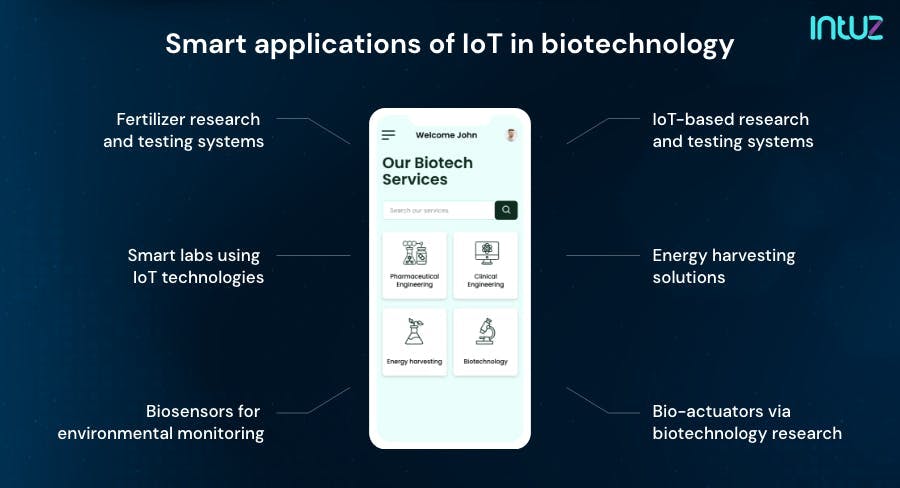The technological overhaul in this day and age is nothing short of impressive. From smart sensors and mobile phones to wearable devices and home automation — the implementation of the Internet of Things (IoT) is pretty much in every aspect of life — whether we like it or not.
The said technology is also set to transform the biotechnology industry and just in time. The constant increase in cost pressures and the accelerated push towards value-based outcomes need flexible manufacturing solutions for businesses to attain sustainability.
It carries tremendous potential for the transformation of biotechnology research, invention, and innovation. Biosciences have witnessed rapid advancements owing to the scientific discoveries in the fields of genetic engineering and stem cell therapies.
However, the biotechnology industry has also become increasingly aware of the complexity involved in implementing and monitoring the required procedures.
The Internet of Things technology is ready to disrupt the ways of conducting biotechnology research and discoveries. It eases the pressure through networking, miniaturization, and automation.
It has improved the quality of our lives by boosting the quality of technology in use. In addition to convenience, it brings down the cost and time involved in the process of moving biological processes and creating control environments.
Let us also not forget the development efforts of cell-based biosensors to enhance the sensing possibilities of a city's IoT ecosystem.
Let's Integrate IoT into Your Biological Process!
Contact Us5 essential Roles of IoT in Biotechnology
The IoT technologies are altering the biotechnical research process by reducing the manual handling of specimens. Researchers now have better control over environmental factors through sensors and can quickly generate reports by comparing historical data and ensuring effective data management.
The key roles IoT devices play in biotechnology are in the following areas:

1. Agricultural-related biological processes and research
The agriculture sector is one of the most important global industries, but it faces many challenges. The world population is growing exponentially, and it is estimated to reach 10 billion by 2050. Agriculture must cope with rising demand for food production while also reducing the impact of environmental factors. Moreover, the disparity in agriculture across regions worldwide cannot be ignored.
Embracing the Internet of Things for agricultural biotechnology provides a suitable alternative to transform agrarian practices. Smart and precision farming is paving the way for technological inculcation in enhancing the productivity of crops.
The Internet of Things enables controlled production accurately while maintaining a hygienic and sustainable environment. IoTs are an integral part of many aspects of modern-day agriculture today, with one primary use being helping farmers.
It includes VRI and IoT systems that measure soil fertility and composition, smart greenhouses that use IoT smart sensors to monitor humidity levels or temperature changes, and intelligent resource management that eliminates waste.
On-ground and aerial drones are revolutionizing agriculture by making farming easier and more efficient. The Internet of Things creation helps monitor farms in real-time to detect irrigation needs, conduct soil variability analysis, assess crop health, and predict disease outbreaks.
2. Research in pharmaceutical biotechnology
The pharmaceutical industry has been challenged with product instability and recalls amidst the pressure of developing new drugs and biologics. Strict regulatory compliance for adopting GMPs/GDP practices makes it tougher to optimize costs.
However, the IoT technology can help them achieve consistency at a global scale along with agility and consistency. Real-time monitoring through sensors speeds up regulatory reporting leading to higher adherence rates in compliance.
A new concept called 'Organ in A Chip' is also developing rapidly. It involves high-throughput screening for sensitive tests against vital diagnostics. Such body sensors make clinical trials safer and less expensive.
Smart labeling, thermo-sensitive packaging, and sterilization using Automatic Information Data Collection (AIDC) have drastically reduced the cost of storage and transport in bio-pharma. This has increased the demand for IoMT app development.
Similarly, patient healthcare monitoring is being done through wearable and ingestible sensing technology. It facilitates targeted action of drugs and intensive patient care remotely, thus saving lives by enabling swift and accurate treatment.
3. Research and development for biotechnology
The high evolutionary pace of novel microbial strains, phages, and other biological breakthroughs requires us to innovate our biotechnological research constantly. IoT technology helps us stay agile by providing precise information.
Reproducibility is another serious challenge as even after providing similar experimental conditions, only a small percentage of results can be replicated. The Internet of Things-enabled equipment helps improve the accuracy of biotechnological research.
The interconnected communication protocols like RF and Bluetooth Low Energy (BLE) facilitate communication between tracking devices. High-end sensors can be used for data collection, and storage on cloud servers, making it easier for researchers to use them.
4. Control and monitoring of the environment
This is where the living systems meet the IoT technology which develops solutions to fulfill the demand from health to food industries. You see, apps with advanced computing abilities can run multiple advanced platforms and enjoy an incredible place in biotechnology.
More importantly, this becomes an essential attraction for industry personnel and scientists alike. Mobile phones and various sensors and devices operating via wireless communications are commonly used for climate control, data management, production management, molecular diagnosis, and education.
5. Research in biomanufacturing
This biotechnology sector makes use of biological systems to produce medical products and therapies, food and beverages, biomaterials, and specialty chemicals.
Biotechnologists are, therefore, making extreme progress in fermentation, cell culturing projects, and recombinant product techniques to make biomanufacturing cost-effective, agile and scalable.
The use of biological raw materials also makes it comparatively more sustainable compared to other manufacturing paradigms. Plus, with the increased adoption of ML and automation, optimizing each step of the production process and its efficiency via bioprocessing is easier.
Critical challenges staring in the face of biotechnology
Biotechnology has carved a niche for itself in varied disciplines. Sure, it is a broad domain, but it comprises many technologies that operate the naturally idle things and turn them into something of increased potential, with the sustainable return of products.
While the benefits of biotechnology are endless, it is marred with several challenges that stare right in its face. This section gives an overview of the same in brief:

1. Monitoring of environmental factors
It is challenging to monitor environmental factors when conducting the same experiments in labs and even in transit of lab specimens. Such variations, unfortunately, lead to discrepancies in outcomes of the same test across labs, causing a negative environmental impact and very different results.
2. Improvement in crop yield
Increasing crop yield has become a necessity due to the rising demand for food. Fluctuating weather conditions, rising pollution, and soil depletion have made it a goal difficult to achieve.
3. Nutrition management in hydroponics
Plant growth is proportionate to its nutrition, but it should also be controlled to avoid damage. Managing fertilizer input is not addressed effectively by traditional methods.
4. Climatic parameters control
Adverse climate affects yield and may even lead to irreversible damage. However, this crucial factor can not be controlled through traditional farming.
5. Controlled microbial population in production
It is nearly impossible to match the high evolutionary pace of novel microbial strains, phages, and other biological organisms. However, it is significant for biotechnological research and the evolution of pharma.
6. Contamination of other microbes in manufacturing
Pharma manufacturing requires sterile environments, and controlling contamination is challenging in the traditional scheme of things.
7. Discarded data management
Despite the large amount of hazardous waste which farms produce, much of it is not discarded properly. Farmers are not aware of how they can best manage their farm's waste. They often use traditional and unhealthy processes to discard farm waste.
8. Publication of new findings and patenting
The mechanism of publishing new findings and registering patents is tedious and incomprehensible. No proper processes are in place.
9. Pest and disease control
Crops are continuously exposed to pest attacks and diseases. Controlling crop loss and poor yield due to pests has always been a challenge. Incessant spraying of chemical-based pesticides degrades the nutritional value of the produce and may even make it harmful for consumption.
10. Automation of tests in the diagnosis of biohazards
Rapid identification, isolation, and treatment of biohazards such as viruses are necessary steps. Laboratory errors such as false-positive and false-negative results are a considerable challenge, including insufficient staff.
Smart applications of IoT in biotechnology
Digital health advisors work tirelessly to improve the quality of our lives. It is their job, and they take that very seriously — especially when the whole world is facing a health crisis.
Naturally, the advancements in surgical procedures, medicine, agriculture, sciences, and others stem from technical achievements and innovations in the field of science.
Add IoT to that, and you have unstoppable solutions, including wireless sensors, that will change the course of history while providing relief. Adding to that thought, here are six Internet of Things-related solutions in biotechnology you must know about:

1. Fertilizer research and testing systems
IoT-enabled sensors are used to measure differences in the pH value of soil. The changes in the pH level indicate a deficiency of macronutrient content in real-time. The system raises an alert and automatically adds the appropriate fertilizer to the soil.
Another advanced method involves testing soil for Nitrogen (N), Phosphorous (P), and Potassium (K) concentration. The sensing in these solutions is based on parameters such as the approximate percentage of NPK to gauge the nutrient contents present in the soil.
The system will also sense the soil's temperature and humidity and give results in real-time, which was earlier not possible.
2. Proposed cloud/IoT-based research and testing systems
Experts in IoT have developed automated systems that will allow laboratories to conduct particular types of biotech research more efficiently. Several instruments will be set up within each IoT-powered lab, and most processes will be automated.
Researchers would not need to create control environments for the setup manually. They would be able to monitor and even conduct the same experiments remotely, thus ensuring their biotech research remains on the right track.
3. Smart labs using IoT technologies
With the help of robots and testing machinery, scientists can conduct research faster and more efficiently. All lab equipment can be tracked through a barcode. Each step of the experiment can be tracked with ease.
It becomes easier to track inventory and maintain them by automatically placing orders before running out of supplies. Smart labs are equipped with IoT-based devices, they send data to the cloud for safe archival and monitoring, keeping security in mind.
Data management, collated from various sources, can easily be analyzed to derive experimental results. Proper record-keeping helps to order and relate inferences with relevant factors, thus improving accuracy.
4. Energy harvesting solutions
The integration of energy harvesting technologies with IoT leads to a new generation of farms, greenhouses, and labs. The IoT edge devices include end-user equipment connected to the networks but act as their power sources.
They use supercapacitors or rechargeable batteries in remote locations where the main power does not have any access control. It reduces the need for battery replacement on an industrial scale and helps cut down costs exponentially, thus maintaining security.
5. Biosensors for environmental monitoring
Xenobiotics are chemicals that come from industrial activities or natural sources. They pollute our environment, putting living organisms at risk. Negative health effects in humans have been recorded to the extent of cancer cell growth.
Biosensors can help with environmental health monitoring and measure the concentration of chemical compounds. These organisms integrate their exposure and respond predictably, making them an excellent method of studying chemical pollution effects on wildlife and humans.
They detect environmental toxins that bring down the quality and sensors placed near them can be used to collect data, thus helping the stakeholders take remedial action before any permanent damage occurs in the long run.
6. Bio-actuators via biotechnology research
These have the potential to be used in a human-friendly manner. Stimulus-responsive hydrogels are biocompatible with human tissues and organs. They respond well enough when they come into contact with various environmental stimuli like pH or temperature changes.
The primary benefit of employing such items for actuation purposes is seen within real-time biosensing systems. They can deliver considerable results in targeted drug delivery and have been declared successful in artificial muscle reconstruction as they engineer new cells more efficiently.
The Internet of Things-enabled equipment helps improve the accuracy of biotechnological research. The wireless communication protocols facilitate communication between tracking devices. High-end sensors can be used for data collection, and storing the same on the cloud.
Transform Your Biotech Plant with IoT Integration!
Explore ServicesOver to you
Without a doubt, the IoT and biotechnology offer a promising technology fusion for sustainable development. By using that technology in the biotechnology sector, we have already seen a lot of advancements.
From smart farms to IoT systems for water, soil, and crop quality monitoring, this technology has increased efficiency and sustainability.
In addition, advanced technologies such as energy harvesting and biosensors will enable smart solutions to address current challenges and improve our ability to monitor and control external factors affecting us.
Book a Free 45-minute Consultation with Our IoT Experts Today! Get a customized roadmap and strategies to leverage IoT for your biotech plant.

